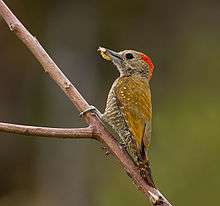Little woodpecker
| Little woodpecker | |
|---|---|
 | |
| Scientific classification | |
| Kingdom: | Animalia |
| Phylum: | Chordata |
| Class: | Aves |
| Order: | Piciformes |
| Family: | Picidae |
| Genus: | Veniliornis |
| Species: | V. passerinus |
| Binomial name | |
| Veniliornis passerinus (Linnaeus, 1766) | |
| Synonyms | |
|
Picus passerinus Linnaeus, 1766 | |
The little woodpecker (Veniliornis passerinus) is a species of bird in the family Picidae, the woodpeckers, piculets, and wrynecks. It is found in a wide range of wooded habitats in a large part of South America east of the Andes, and generally common. Unlike other similar and comparably sized members of the genus Veniliornis, the little woodpecker lacks a contrasting yellow nape.
In 1760 the French zoologist Mathurin Jacques Brisson included a description of the little woodpecker in his Ornithologie based on a specimen collected in Saint-Domingue (now Haiti). He used the French name Le petit pic de S. Domingue and the Latin name Picus dominicensis minor.[2] Although Brisson coined Latin names, these do not conform to the binomial system and are not recognised by the International Commission on Zoological Nomenclature.[3] When in 1766 the Swedish naturalist Carl Linnaeus updated his Systema Naturae for the twelfth edition he added 240 species that had been previously described by Brisson.[3] One of these was the little woodpecker. Linnaeus included a terse description, coined the binomial name Picus passerinus and cited Brisson's work.[4] Linnaeus mistakenly specified the type location as Dominica. This has been corrected to Cayenne in French Guiana.[5] The specific name passerinus is from Latin and means "sparrow like".[6] This species is now placed in the genus Veniliornis that was introduced by the French ornithologist Charles Lucien Bonaparte in 1854.[7]
References
- ↑ BirdLife International (2012). "Veniliornis passerinus". IUCN Red List of Threatened Species. Version 2013.2. International Union for Conservation of Nature. Retrieved 26 November 2013.
- ↑ Brisson, Mathurin Jacques (1760). Ornithologie, ou, Méthode contenant la division des oiseaux en ordres, sections, genres, especes & leurs variétés (in French and Latin). Volume 4. Paris: Jean-Baptiste Bauche. pp. 75–77, Plate 4 fig 2. The two stars (**) at the start of the paragraph indicates that Brisson based his description on the examination of a specimen.
- 1 2 Allen, J.A. (1910). "Collation of Brisson's genera of birds with those of Linnaeus". Bulletin of the American Museum of Natural History. 28: 317–335.
- ↑ Linnaeus, Carl (1766). Systema naturae : per regna tria natura, secundum classes, ordines, genera, species, cum characteribus, differentiis, synonymis, locis (in Latin). Volume 1, Part 1 (12th ed.). Holmiae (Stockholm): Laurentii Salvii. p. 174.
- ↑ Peters, James Lee, ed. (1948). Check-list of Birds of the World. Volume 6. Cambridge, Massachusetts: Harvard University Press. p. 172.
- ↑ Jobling, J.A. (2018). del Hoyo, J.; Elliott, A.; Sargatal, J.; Christie, D.A.; de Juana, E., eds. "Key to Scientific Names in Ornithology". Handbook of the Birds of the World Alive. Lynx Edicions. Retrieved 2 April 2018.
- ↑ Bonaparte, Charles Lucien (1854). "Quadro dei volucri zigodattili, ossia passeri a piedi scansori". L'Ateneo Italiano raccolta di documenti e memorie relative al progresso delle scienze fisiche. 2: 116-129 [125].
External links
- Little woodpecker videos on the Internet Bird Collection
- Little woodpecker photo gallery VIREO Photo-High Res--(Close-up)
- Photo-High Res; Article www.ib.usp.br–"Picidae"
